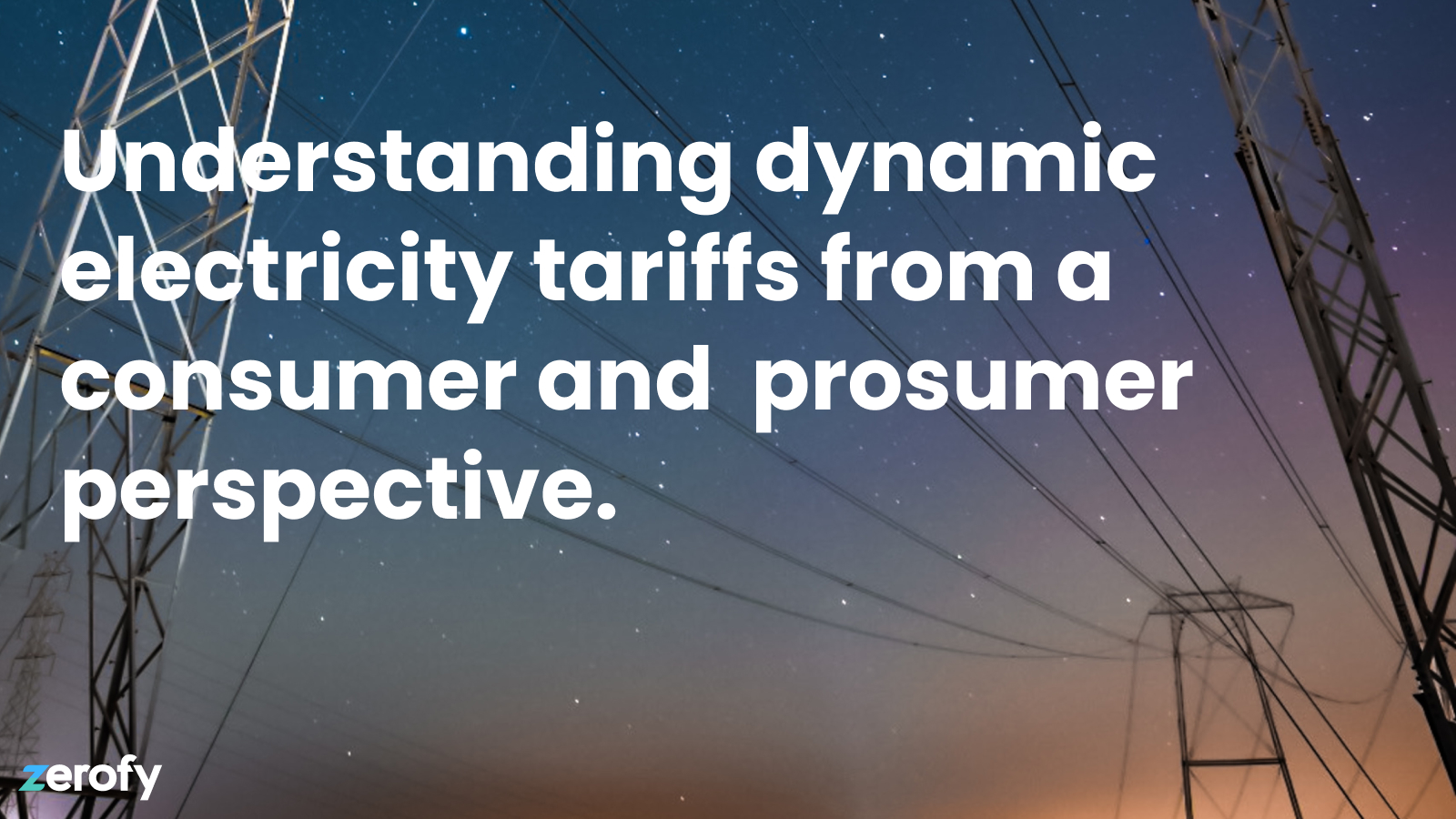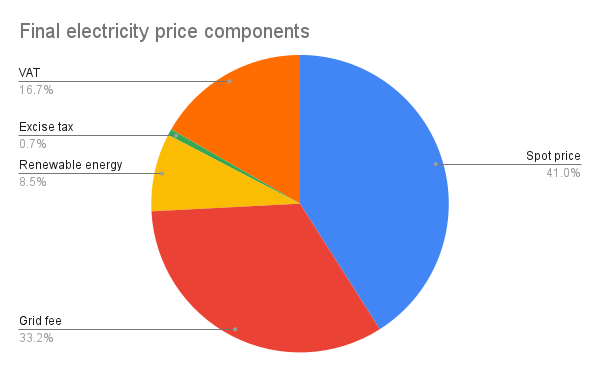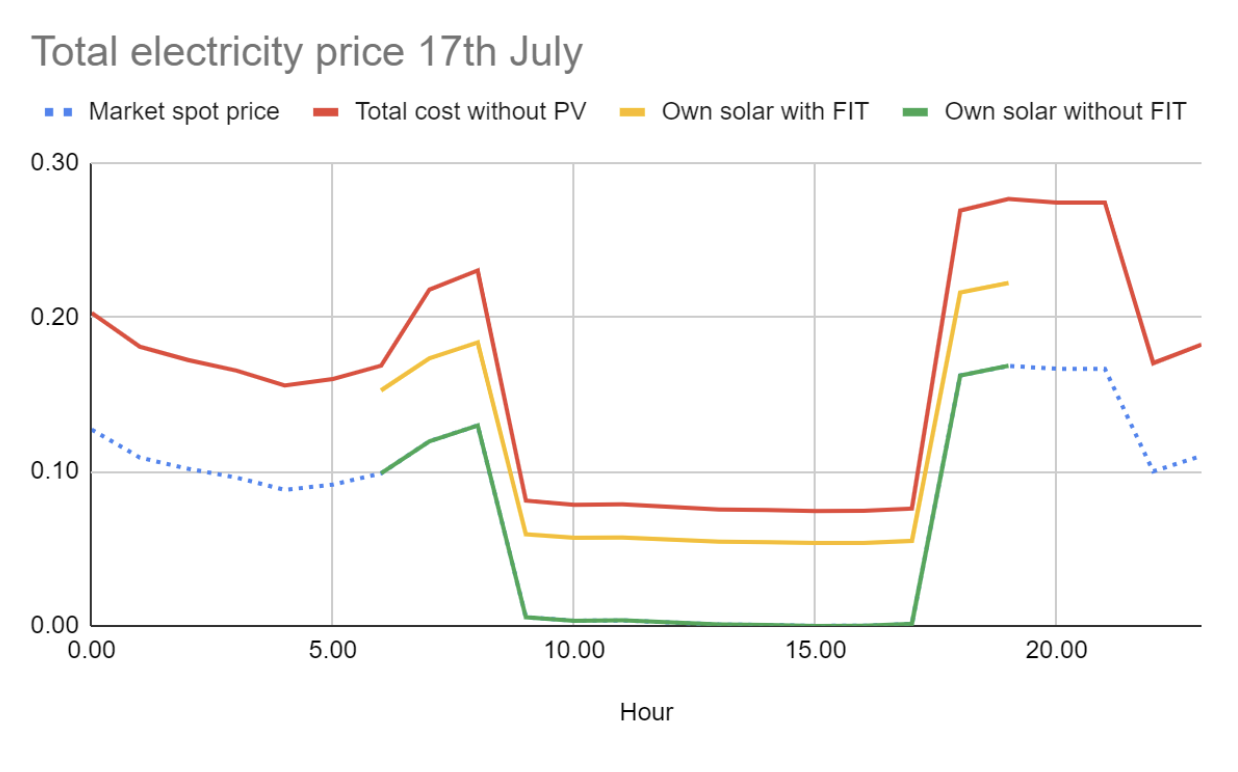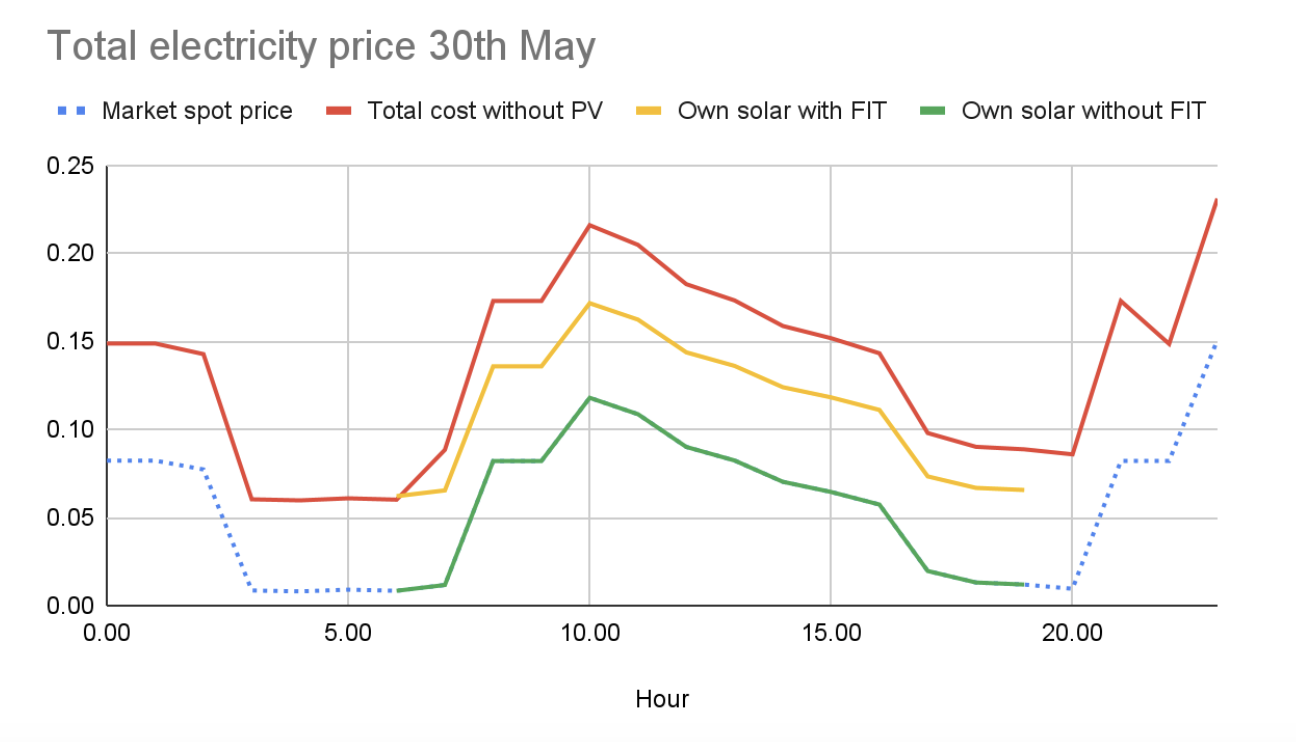
Although the European retail electricity market was liberalized a long time ago, only in some countries smart-meter rollout has led to widespread availability and adoption of innovative products such as dynamic retail electricity tariffs. In light of the accelerating momentum for electrification of the energy system and households, it’s helpful to look at these leading markets for inspiration and the economics of home energy management in such an environment.
In this article we look at the composition of (dynamic) retail electricity prices and its impact on energy cost optimisation for electrified households with solar and high electricity consumption (EV and heat pump).
Understanding retail electricity prices
The most common dynamic tariff model is one that follows the European day-ahead spot market price, for example Epex or in Scandinavia Nord Pool. But the price that end-users are paying for electricity is of course not purely the market price for electricity generation. It consists of at least three components that depend on the country and region. In addition, to optimize the home energy system from a monetary perspective, we also need to know the value of the home produced solar electricity.
The first component of electricity price is the cost for electrical energy generation that we pay for energy providers or utilities. This might be fixed price or spot price. Fixed price contracts might also have different prices for daily and nightly time. These are also called off peak rates in some countries. In countries where smart meters penetration is high and prices are volatile, dynamic tariffs are popular. This is the case in Scandinavia and Baltics where wholesale electricity prices are passed through to final customers with hourly metering.
The second component is grid network tariff that is the cost of transmission and distribution of electricity. This can be flat, capacity or volume based as well as static or dynamic. There are also many pricing options available depending on the country and grid operator where the consumer is based. Time of use tariffs with daily and nightly rates are quite popular. Dynamic network tariffs with hourly differences have been so far considered too complex and not proven pricing methodology. But in some countries (e.g. The Netherlands) there are fixed network tariffs that do not incentivize the use of grid resources effectively.
Lastly, taxes and levies are the components that are increasing the former costs. Typically there is renewable energy levy, excise duty and value added tax.
Adding your own solar production to the calculation
On a high level, you can benefit economically from your own solar production:
- Use your solar production locally in your house. This is beneficial at high electricity prices, and a very important factor is that you avoid the grid fees (which can make up 30% of the electricity prices) and taxes when using electricity directly locally
- Feeding your electricity into the grid and getting paid for it
When you are generating electricity with solar panels and can sell excessive electricity to the grid, you should consider the value of your own production also. If you have no feed in tariff or premium available and are getting only market price for electricity, mainly it is most beneficial to consume the solar production at site when it is generated. (This is due to the avoidance of grid fees and state taxes for self-generated electricity.) But if you are benefitting from a feed-in tariff, it might be sometimes more economical to sell the excess solar electricity to the grid during the day and charge your EV during low price hours at night. To make those decisions you need to know the total cost of electricity and compare it with the price of the solar electricity that you would receive for feed in. This means the cost for using your own solar electricity is the lost income you have from grid feed-in, if you had fed the electricity to the grid instead of used it locally.
Estonian example
In Estonia, there are less than ten electricity providers that sell electricity to retail customers. There is only one distribution grid company that connects the majority of consumers. Nevertheless, there are in total at least 20+ price plans for buying electricity and about 5+ different plans for network services.
Depending on the power generation portfolios and transmission availability in the region (also season and many other factors) prices might be lower during the day or during the night. Summing up the electricity price hourly components gives us a total price for each hour to decide whether to start devices or not.
Final electricity price components are depicted on the next graph (with electricity price taken as 60 EUR/MWh for the specific hour). It can be seen that the share of the actual electricity generation price is less than half of the total price per kWh you pay as a household when consuming from the grid. If you have solar production at your home, this also means you save all these additional costs from taxes and grid fees - but if you benefit from a feed-in tariff it may still be more attractive to sell the elctricity than self-consuming, as we’ll explain below.

Let’s now look at two days from this summer with different spot price patterns. On 17th of July, spot prices were following a typical pattern from the current summer - daily prices are lower than nightly.

The chart shows the spot price (market price) with the blue line. The red line shows the actual consumer retail electricity price with taxes and grid fees added to the raw spot price. The green line then shows the (opportunity) cost of using your own solar production, which is the price you would get when you would feed it into the grid for the case without special feed-in-tariff (FIT). (You just get paid the spot price). And the yellow line shows the cost for using your own solar, where you benefit from a fixed feed-in-tariff _on top of _the spot price when feeding into the grid. All these are real data from Estonia for Jul 17 2023.
In this example the lowest prices are from your own solar, both with and without feed-in tariff, during the day. On many days this summer we have even seen negative prices at midday also on July 17th. In those cases it makes total sense to charge the EV or activate any other shiftable loads during the solar production (irrespective of the availability of FIT).
But in previous years the pattern looked more like it was on 30th of May this year - spot prices were contrarily higher during the day. Selling solar production during the day to the grid and charging EV during the cheap nightly hours is economically more beneficial in this case.

Conclusion
In summary, for prosumer households with solar, optimizing the consumption by cost is more complex than either simply looking at the cheapest spot price hours or always first optimizing for solar self consumption before selling to the grid. The calculations become even more interesting and complex when adding batteries to the mix, or when not only considering price but also CO2 intensity or a joint optimisation. Both topics for future posts.
If you are interested in reading more like this, follow us on Twitter or Linkedin - or maybe you’d like to join the waitlist for our upcoming app, which helps electrified households to optimize their energy consumption with scenarios like the above. We’re actively looking for test users who’d like to try the app and give us feedback.